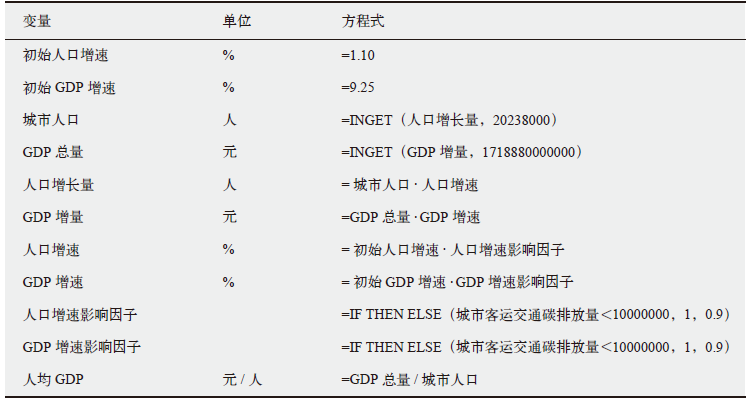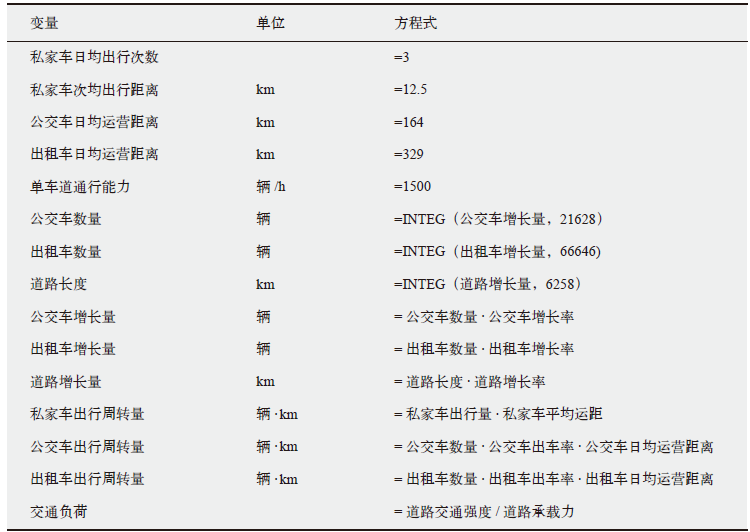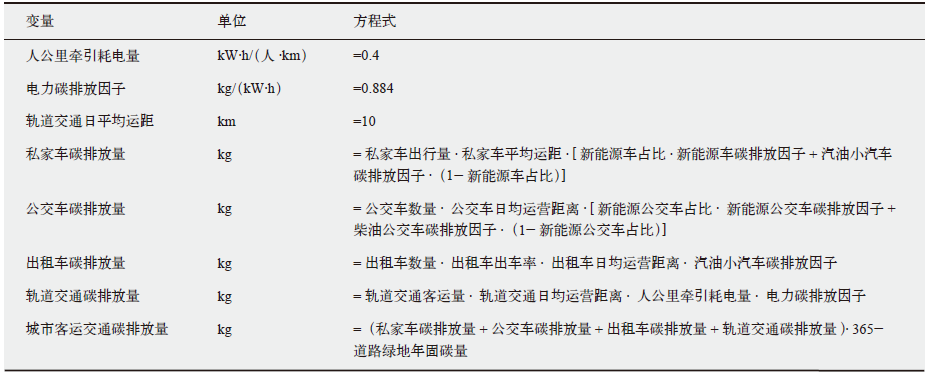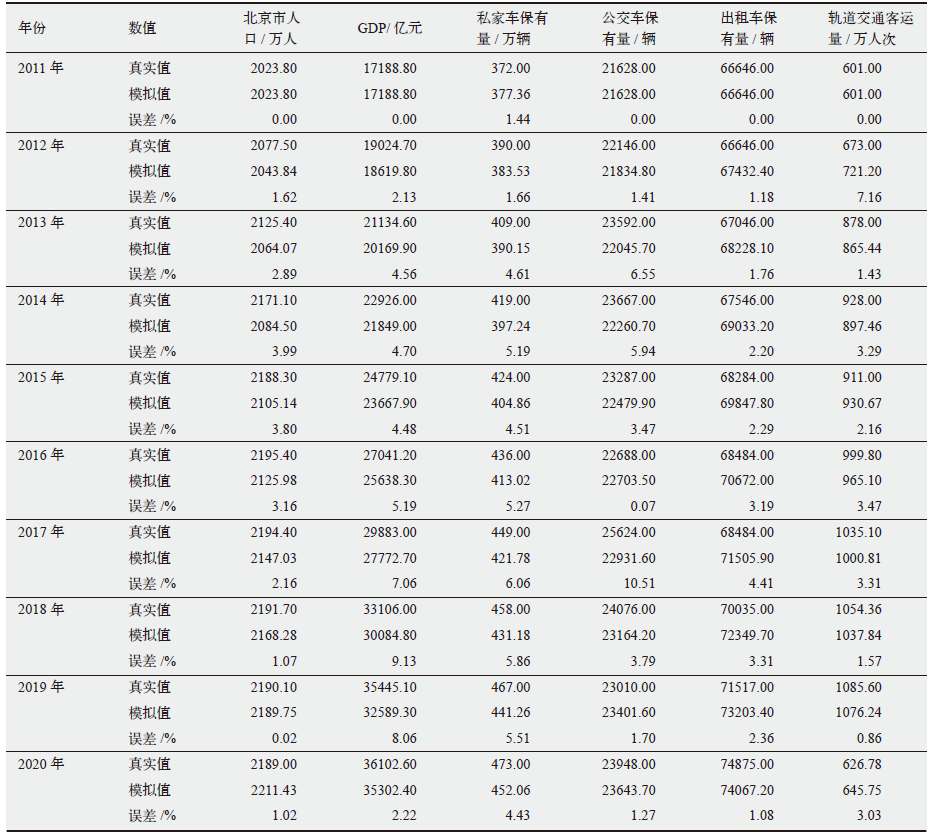Climate Change Research ›› 2023, Vol. 19 ›› Issue (3): 357-370.doi: 10.12006/j.issn.1673-1719.2022.138
• Greenhouse Gas Emissions • Previous Articles Next Articles
Scenario simulation of urban passenger transportation carbon reduction based on system dynamics
GE Qiu-Yu, XU Yi-Nuo, QIU Rong-Zu, HU Xi-Sheng, ZHANG Yuan-Yuan, LIU Na-Cui, ZHANG Lan-Yi( )
)
- College of Transportation and Civil Engineering, Fujian Agriculture and Forestry University, Fuzhou 350108, China
-
Received:2022-05-31Revised:2022-07-12Online:2023-05-30Published:2022-12-09
Cite this article
GE Qiu-Yu, XU Yi-Nuo, QIU Rong-Zu, HU Xi-Sheng, ZHANG Yuan-Yuan, LIU Na-Cui, ZHANG Lan-Yi. Scenario simulation of urban passenger transportation carbon reduction based on system dynamics[J]. Climate Change Research, 2023, 19(3): 357-370.
share this article
Add to citation manager EndNote|Ris|BibTeX
URL: http://www.climatechange.cn/EN/10.12006/j.issn.1673-1719.2022.138
| [1] | 胡晓伟, 包家烁, 安实, 等. 碳达峰下城市交通运输减排治理策略研究[J]. 交通运输系统工程与信息, 2021, 21 (6): 244-256. |
| Hu X W, Bao J S, An S, et al. Urban transportation emission reduction governance strategies under peak carbon dioxide emissions[J]. Journal of Transportation Systems Engineering, 2021, 21 (6): 244-256 (in Chinese) | |
| [2] |
Zhang L L, Long R Y, Li W B, et al. Potential for reducing carbon emissions from urban traffic based on the carbon emission satisfaction: case study in Shanghai[J]. Journal of Transport Geography, 2020, 85: 102733
doi: 10.1016/j.jtrangeo.2020.102733 URL |
| [3] | 林丹婷, 张兰怡, 陈诚, 等. 城市核心区域乘用车碳排放的时空分布特征[J]. 福建农林大学学报: 自然科学版, 2019, 48 (5): 664-672. |
| Lin D T, Zhang L Y, Chen C, et al. Spatiotemporal distribution characteristics of the carbon emission from passenger cars in urban core region[J]. Journal of Fujian Agriculture and Forestry University: Natural Science Edition, 2019, 48 (5): 664-672 (in Chinese) | |
| [4] |
Lin D T, Zhang L Y, Chen C, et al. Understanding driving patterns of carbon emissions from the transport sector in China: evidence from an analysis of panel models[J]. Clean Technologies and Environmental Policy, 2019, 21 (6): 1307-1322
doi: 10.1007/s10098-019-01707-y URL |
| [5] | 黄莹, 郭洪旭, 廖翠萍, 等. 基于LEAP模型的城市交通低碳发展路径研究: 以广州市为例[J]. 气候变化研究进展, 2019, 15 (6): 670-683. |
| Huang Y, Guo H X, Liao C P, et al. Study on low-carbon development path of urban transportation sector based on LEAP model: take Guangzhou as an example[J]. Climate Change Research, 2019, 15 (6): 670-683 (in Chinese) | |
| [6] | 张兰怡, 卢秋萍, 张园园, 等. 福建省交通碳排放影响因素与减碳趋势研究[J]. 哈尔滨商业大学学报:自然科学版, 2022, 38 (3): 360-375. |
| Zhang L Y, Lu Q P, Zhang Y Y, et al. Research on influencing factors and carbon reduction trend of transportation carbon emissions in Fujian Province[J]. Journal of Harbin University of Commerce: Natural Sciences Edition, 2022, 38 (3): 360-375 (in Chinese) | |
| [7] | 戈秋虞, 张兰怡, 邱荣祖, 等. 基于GDIM法的福建省交通碳排放驱动因素分析[J]. 福建农林大学学报: 自然科学版, 2022, 51 (1): 131-136. |
| Ge Q Y, Zhang L Y, Qiu R Z, et al. Analysis on driving factors of transportation carbon emissions in Fujian Province based on GDIM[J]. Journal of Fujian Agriculture and Forestry University: Natural Science Edition, 2022, 51 (1): 131-136 (in Chinese) | |
| [8] | Wei L, Bai L. System dynamics modeling and policy simulation for urban traffic: a case study in Beijing[J]. Environmental Modeling & Assessment, 2017, 22 (4): 363-378 |
| [9] |
Liu X, Ma S F, Tian J F, et al. A system dynamics approach to scenario analysis for urban passenger transport energy consumption and CO2emissions: a case study of Beijing[J]. Energy Policy, 2015, 85: 253-270
doi: 10.1016/j.enpol.2015.06.007 URL |
| [10] | 王继峰, 陆化普, 彭唬. 城市交通系统的SD模型及其应用[J]. 交通运输系统工程与信息, 2008, 8 (3): 83-89. |
| Wang J F, Lu H P, Peng H. System dynamics model of urban transportation system and its application[J]. Journal of Transportation Systems Engineering, 2008, 8 (3): 83-89 (in Chinese) | |
| [11] | 麦文隽, 邹乐乐, 王毅, 等. 城市客运交通节能减排潜力分析: 以镇江市为例[J]. 城市问题, 2017 (8): 31-41. |
| Mai W J, Zou L L, Wang Y, et al. Analysis to the potential of energy-saving and emission-reduction of urban passenger transport: a case study of Zhenjiang city[J]. Urban Problems, 2017 (8): 31-41 (in Chinese) | |
| [12] | 魏贤鹏, 朝鲁, 战秋艳, 等. 基于系统动力学的城市道路交通污染控制问题研究[J]. 数学的实践与认识, 2017, 47 (23): 117-126. |
| Wei X P, Zhao L, Zhan Q Y, et al. Research on urban road traffic pollution control based on system dynamics[J]. Mathematics in Practice and Theory, 2017, 47 (23): 117-126 (in Chinese) | |
| [13] |
Nima S, Hajinezhad A, Noorollahi Y. Developing a system dynamics approach for CNG vehicles for low-carbon urban transport: a case study[J]. International Journal of Low-Carbon Technologies, 2021, 16 (2): 577-591
doi: 10.1093/ijlct/ctaa085 URL |
| [14] |
İrfan B, Bayram I, Koc M. Impact assessment of supply-side and demand-side policies on energy consumption and CO2 emissions from urban passenger transportation: the case of Istanbul[J]. Journal of Cleaner Production, 2019, 219: 391-410
doi: 10.1016/j.jclepro.2019.02.064 URL |
| [15] | 邵艳, 张弢, 牟星宇. 高速公路路域范围内绿地的碳清除作用[J]. 公路交通科技: 应用技术版, 2018, 14 (9): 322-324. |
| Shao Y, Zhang T, Mou X Y. Carbon removal effect of green space in highway area[J]. Journal of Highway and Transportation Research and Development, 2018, 14 (9): 322-324 (in Chinese) | |
| [16] | 邓旭东, 刘春玲, 赵利利, 等. 考虑双积分和碳交易背景下基于最优控制的新能源汽车生产决策分析[J/OL]. 计算机集成制造系统, 2022 [2022-05-20]. http://kns.cnki.net/kcms/detail/11.5946.TP.20220317.2003.005.html. |
| Deng X D, Liu C L, Zhao L L, et al. Production decision analysis of new energy vehicles based on optimal control considering dual credit and carbon trade policy[J/OL]. Computer Integrated Manufacturing Systems, 2022 [2022-05-20]. http://kns.cnki.net/kcms/detail/11.5946.TP.20220317.2003.005.html (in Chinese) | |
| [17] | 李茜. 城市客运交通能源需求与碳排放预测方法及其应用研究[D]. 北京: 北京理工大学, 2018. |
| Li Q. Study on the energy demand and carbon emissions prediction method and its application in urban passenger transport sector[D]. Beijing: Beijing Institute of Technology, 2018 (in Chinese) | |
| [18] | 李沛妍. 基于系统动力学的城市低碳交通发展模式与结构优化[D]. 西安: 西安建筑科技大学, 2018. |
| Li P Y. Urban low carbon transportation development model and structure optimization based on system dynamics[D]. Xi’an: Xi’an University of Architecture and Technology, 2018 (in Chinese) | |
| [19] | 刘爽. 基于系统动力学的大城市交通结构演变机理及实证研究[D]. 北京: 北京交通大学, 2010. |
| Liu S. Mechanism and empirical analysis on the evolution of urban traffic structure based on system dynamics[D]. Beijing: Beijing Jiaotong University, 2010 (in Chinese) | |
| [20] | 张青云, 吕伟娅, 徐炳乾. 华北地区城市绿地固碳能力测算研究[J]. 环境保护科学, 2021, 1 (47): 41-48. |
| Zhang Q Y, Lv W Y, Xu B Q. Study on the calculation of carbon sequestration capacity of urban green space in North China[J]. Environmental Protection Science, 2021, 1 (47): 41-48 (in Chinese) | |
| [21] | 邓吴婕, 李楠, 陈智, 等. 深圳特区城市植被的固碳释氧效应[J]. 中山大学学报: 自然科学版, 2010, 4 (49): 86-92. |
| Deng W J, Li N, Chen Z, et al. The effect of CO2 sequestration and O2 release of urban vegetation in Shenzhen special zone[J]. Acta Scientiarum Naturalimu Universitatis Sunyatseni, 2010, 4 (49): 86-92 (in Chinese) | |
| [22] | 赵艳玲. 上海社区绿地植物群落固碳效益分析及高固碳植物群落优化[D]. 上海: 上海交通大学, 2014. |
| Zhao Y L. Analysis on carbon fixation effection and optimizational disposition about plant communities of community greenspace in Shanghai[D]. Shanghai: Shanghai Jiao Tong University, 2014 (in Chinese) | |
| [23] | 金力豪. 园林植物碳储存及碳汇效益研究: 以杭州云制造小镇为例[D]. 杭州: 浙江农林大学, 2019. |
| Jin L H. Carbon storage and carbon sink benefits of garden plants: taking cloud manufacturing town as an example[D]. Hangzhou: Zhejiang A&F University, 2019 (in Chinese) | |
| [24] | 吕晨, 张哲, 陈徐梅, 等. 中国分省道路交通二氧化碳排放因子研究[J]. 中国环境科学, 2021, 41 (7): 3122-3130. |
| Lv C, Zhang Z, Chen X M, et al. Study on CO2 emission factors of road transport in Chinese provinces[J]. China Environmental Science, 2021, 41 (7): 3122-3130 (in Chinese) | |
| [25] | 北京市统计局. 北京统计年鉴[R]. 北京: 中国统计出版社, 2020. |
| Bureau of Statistics of Beijing. Beijing statistical yearbook[R]. Beijing: China Statistics Press, 2020 (in Chinese) | |
| [26] | 北京交通发展研究院. 2020年北京交通发展年报 [EB/OL]. 2020 [2022-05-27]. https://www.bjtrc.org.cn/List/index/cid/7.html. |
| Beijing Transport Institute. 2020 Beijing transport development annual report [EB/OL]. 2020 [2022-05-27]. https://www.bjtrc.org.cn/List/index/cid/7.html (in Chinese) | |
| [27] | 中华人民共和国环境保护部. 道路机动车大气污染物排放清单编制技术指南 (试行)[R]. 北京: 中华人民共和国环境保护部门科技标准司, 2014. |
| Ministry of Environment Protection of The People’s Republic of China. Technical guide for preparation of air pollutant emission list of road motor vehicles (Trial)[R]. Beijing: Department of Technology Standards of Ministry of Environment Protection of The People’s Republic of China, 2014 (in Chinese) | |
| [28] |
贾书伟, 严广乐. 基于SD-GM循环预测理论的机动车污染物收费政策效应分析[J]. 系统工程理论与实践, 2019, 39 (9): 2436-2450.
doi: 10.12011/1000-6788-2018-1593-15 URL |
| Jia S W, Yan G L. Effects of the policy of air pollution charging fee based on system dynamics and grey model approach[J]. System Engineering-Theory &Practice, 2019, 39 (9): 2436-2450 (in Chinese) | |
| [29] | 盛强. 交通领域碳减排的影响机制及情景分析: 以北京市为例[D]. 北京: 北京化工大学, 2018. |
| Sheng Q. The impact mechanism and scenario analysis of carbon emission reduction in transportation sector: a case study of Beijing[D]. Beijing: Beijing University of Chemical Technology, 2018 (in Chinese) | |
| [30] |
庞可, 张芊, 马彩云, 等. 基于LEAP模型的兰州市道路交通温室气体与污染物协同减排情景模拟[J]. 环境科学, 2022, 43 (7): 3386-3395. DOI: 10.13227/j.hjkx.202109119.
doi: 10.13227/j.hjkx.202109119 URL |
|
Pang K, Zhang Q, Ma C Y, et al. Forecasting of emission co-reduction of greenhouse gases and pollutants for the road transport sector in Lanzhou based on the LEAP model[J]. Environmental Science, 2022, 43 (7): 3386-3395. DOI: 10.13227/j.hjkx.202109119 (in Chinese)
doi: 10.13227/j.hjkx.202109119 URL |
|
| [31] | 陈振, 昝哲. 郑州市交通政策影响的系统动力学模型与仿真[J]. 河南农业大学学报, 2021, 55 (5): 917-927. |
| Chen Z, Zan Z. Modeling and simulation of urban traffic policy impact based on system dynamics of Zhengzhou city[J]. Journal of Henna Agricultural University, 2021, 55 (5): 917-927 (in Chinese) |
| [1] | TAN Xian-Chun, CHENG Yong-Long, GU Bai-He. New progress in controlling the total volume of carbon emissions in China: a review on the allocation of provincial carbon emission allowances [J]. Climate Change Research, 2023, 19(1): 63-73. |
| [2] | LIU Ji-Yi, ZHANG Yi-Chen, ZHANG Dong-Yu, FU Lin, CAO Ying. Analysis and enlightenment of the latest European Effort Sharing Regulation [J]. Climate Change Research, 2022, 18(6): 756-763. |
| [3] | TAO Xue-Zong, WANG Qian-Yi, LI Han-Qing. Economical analysis of vessels’ shore power usage [J]. Climate Change Research, 2022, 18(4): 492-502. |
| [4] | FENG Guo-Hui, CUI Hang, CHANG Sha-Sha, HUANG Kai-Liang, WANG Xi-Ru. Analysis of carbon emissions and influencing factors of near-zero energy buildings [J]. Climate Change Research, 2022, 18(2): 205-214. |
| [5] | HE Feng, LIU Zheng-Yan, XING You-Kai, GAO Yu-Bing, MAO Xian-Qiang. Co-control effect evaluation of the energy saving and emission reduction measures in Chinese cement industry [J]. Climate Change Research, 2021, 17(4): 400-409. |
| [6] | YUAN Yuan, SUN Xin-Tong. Exploring the relationship between urbanization, industrial structure, energy consumption, economic growth and CO2 emissions: an empirical study based on the heterogeneity of inter-provincial income levels in China [J]. Climate Change Research, 2020, 16(6): 738-747. |
| [7] | CAO Ying,ZHENG Xiao-Qi,LIU Qiang. The correlation analysis between urbanization mode and low carbon development—taking Shijiazhuang as an example [J]. Climate Change Research, 2020, 16(2): 223-231. |
| [8] | Ying HUANG,Hong-Xu GUO,Cui-Ping LIAO,Dai-Qing ZHAO. Study on low-carbon development path of urban transportation sector based on LEAP model—take Guangzhou as an example [J]. Climate Change Research, 2019, 15(6): 670-683. |
| [9] | Ji-Feng LI,A-Lun GU,Cheng-Long ZHANG,Zhen-Qing SUN. Economic development, energy demand and carbon emission prospects of China’s provinces during the 14th Five-Year Plan—an application of CMRCGE model [J]. Climate Change Research, 2019, 15(6): 649-659. |
| [10] | Xiao-Ting CHEN, Ying CHEN. The scientific and political views of carbon budget for global climate governance [J]. Climate Change Research, 2018, 14(6): 632-639. |
| [11] | Zhi-Xin FAN,Xiu-Qi FANG,Yun SU. Changes in global grid pattern of carbon emissions [J]. Climate Change Research, 2018, 14(5): 505-512. |
| [12] | Qing-Qing LI,Ying SU,Li SHANG,Wei WEI,Mao-Hua WANG. Comparison analysis of China’s emissions accounting by typical international carbon databases [J]. Climate Change Research, 2018, 14(3): 275-280. |
| [13] | Jie-Ming CHOU, Ru-Feng DAI, Wen-Jie DONG, Jing-Han BAN, Chuan-Ye HU. Future CO2 emissions projection of China based on U.S. new climate policy [J]. Climate Change Research, 2018, 14(1): 95-105. |
| [14] | Yi Si, Tan Jinkai, Li Mengya, Liang Xinxin, Wang Jun. Projection of Sea Level Rise and Its Impacts on Coastal Wetlands Within the Yangtze Estuary [J]. Climate Change Research, 2017, 13(6): 598-605. |
| [15] | Song Jingni, Wu Qunqi, Yuan Changwei, Zhang Shuai, Bao Xu, Du Kai. Spatial-Temporal Characteristics of China Transport Carbon Emissions Based on Geostatistical Analysis [J]. Climate Change Research, 2017, 13(5): 502-511. |
| Viewed | ||||||
|
Full text |
|
|||||
|
Abstract |
|
|||||


















